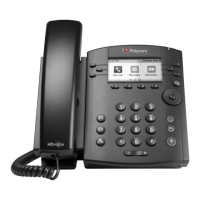• Brightness Level—Sets how brightly your video displays. You can set a level between 0 (dimmest)
and 6 (brightest). The default level is 3.
• Saturation Level—Sets how much color your video displays. You can set a level between 0 (lowest)
and 6 (highest). The default level is 3.
• Contrast Level—Sets the difference in brightness between the light and dark areas of your video.
You can set a level between 0 (no contrast increase) and Auto (noise reduction contrast). The
default level is 0.
• Sharpness Level—Sets the clarity of detail in your video. You can set a level between 0 (lowest)
and 6 (highest). The default level is 3.
• Flicker Avoidance—Adjusts the flickering of your video captured by the camera sensor. You can
select 50 Hz (flicker avoidance for Europe and Asia) or 60 Hz (flicker avoidance for North America).
The default is 50 Hz.
Procedure
1. Go to Settings > Basic > Video > Camera Settings.
2. From the Camera Settings screen, select and adjust the desired camera settings.
Changing the Video Call and Picture-in-Picture (PIP) Displays
You can set up your phone so that it displays all video during calls in specific ways. You can choose to do
the following:
• Display all incoming video calls on the full screen
• Change the way video displays
• View full-screen video with or without the picture-in-picture (PIP)
• Display the PIP next to, or over, full-screen video
Your video image displays at the top-right of the screen in a PIP video, as shown next. The PIP displays
on your Home screen and during video calls. When you're in a call with a person that has video enabled,
your video is displayed in the PIP. The person you're talking with (the far-side) is displayed in the Active
Call screen.
Figure 12: Call window with PIP and far-side video
Customize how and where you see your PIP video and the far-side video. For example, you swap the
windows in which the video displays or start and stop your video transmission.
Video Calls on Poly VVX
87

